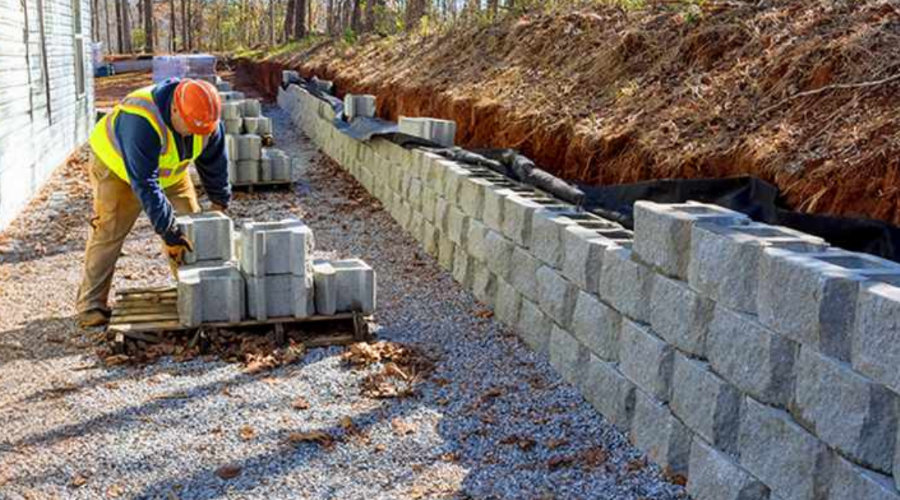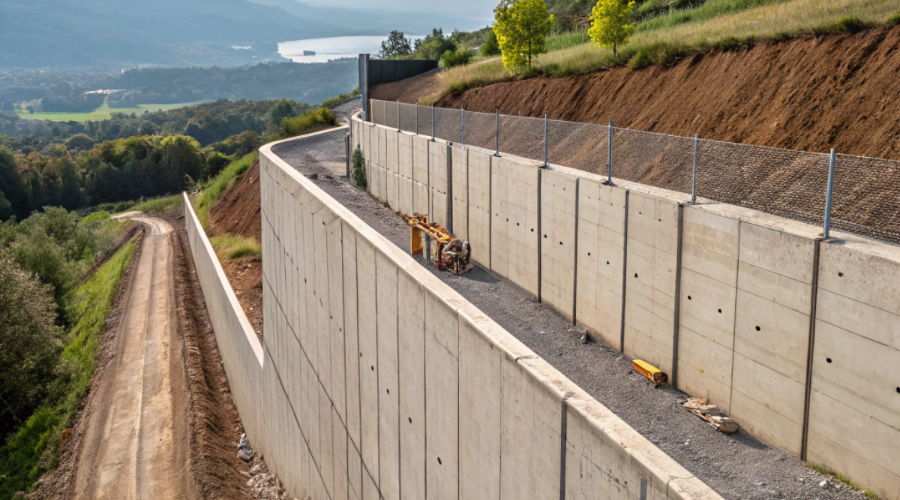Is your land built on sloping or uneven ground, where loose soil and rainwater would flow downhill without control? This would make it difficult to control drainage and prevent the soil from shifting. As a result, erosion could occur, causing damage to your foundation. The solution? A concrete retaining wall. It effectively stops erosion and improves your landscape.
Are you interested in learning how a simple structure can effectively protect your home and enhance the appearance of your property? Let us get started.
About Concrete Retaining Walls
Concrete retaining walls are strong barriers that resist soil movement. They are typically used where support is required to prevent the soil from sliding.
A concrete retaining wall is an excellent option if your land is on a slope. It levels the area and creates a stable, functional outdoor space.
Types of Concrete Retaining Walls
Different types of concrete retaining walls exist. Each one has its own advantages and fits different requirements. Let us discuss the common types below.
1. Gravity Retaining Walls

Gravity Retaining walls stay in place using their own weight to hold back the soil. They are usually made of large blocks, precast concrete panels, or solid concrete.
2. Cantilever Retaining Walls

These walls have a strong concrete base with a flat slab that extends into the soil behind them. This design helps balance the pressure from the soil, keeping the wall stable.
3. Counterfort Retaining Walls
Similar to cantilever walls, Counterfort Retaining Walls feature vertical concrete supports at the back, which add extra strength and stability.
4. Tieback Retaining Walls
These walls have steel anchors or cables extending into the ground for added support, balancing the pressure of the soil.
5. Segmental Retaining Walls
They are made of interlocking concrete blocks or precast panels. These materials create a strong and durable structure.
6. Anchored Earth Retaining Walls
These combine gravity or cantilever wall designs with tiebacks, using both weight and horizontal anchors to hold back soil.
Why Concrete Retaining Walls Are a Smart Choice?
You can construct retaining walls with materials such as bricks or wood. But most homeowners opt for concrete because of the following reasons:
1. Strong and Durable
Concrete retaining walls are highly strong, long-lasting, and low maintenance. Concrete becomes hardened with time so that it can serve for years. Furthermore, they need little maintenance and hardly need repairing.
2. Customisable
Concrete retaining walls are functional. They also make your property look attractive. You can customise them with plants, metal designs, or textured finishes. They can be utilized to create seating areas and walkways. This adds beauty and functionality to your outdoor space.
3. Affordable
Concrete retaining walls are durable. They are economic solutions as they do not require frequent repairs and replacement. They also provide additional protection to the property and save costs on repairs in the future. So they are modest investment for homeowners and builders alike.
Selecting the Ideal Concrete Retaining Wall Design
To choose the right solution for your needs, many factors must be considered. These include:
1. Consider the Location
You need to check the ground conditions prior to starting your retaining wall project. Note the elevation of the land, utilities and structures around the area. This helps determine the best material, design, and size for the wall. Be sure to understand property lines and underground systems like stormwater and irrigation for safety.
2. Examine the Soil
The quality of the soil is crucial for Retaining Wall Design. Test the soil for its type, strength, and ability to hold to ensure it can support your wall. Avoid organic soil, as it deteriorates over time, reducing the wall’s lifespan and increasing costs
3. Purpose of the Wall
Take some time to think about what you want the retaining wall to do. Is it to hold soil, or is it for aesthetics? Having an idea of its purpose will enable you to choose the right design and materials that are both functional and pleasing to the eye. This decision will also decide how the wall will interact with the rest of your environment.
Steps To Build Concrete Retaining Walls
Concrete retaining wall construction requires serious planning and care and has to be handled precisely. Each step will guide you through the most important aspects from the preparation to the finishing. Below is a clear guide to help you through each stage of the process.
- This design should be sketched before the wall construction. It is highly essential to assess the parameters of size, shape, and materials to be used so that the wall meets your requirements and complies with the local law.
- Remove anything blocking the construction of the wall. Clear away debris, vegetation, and rocks. Measure the area and mark the layout for proper positioning.
- Dig a trench as deep as required by the design and the height of the wall. The trench should be level and wide enough to fit the concrete base.
- Concrete mixing needs to be performed based on the manufacturer’s specifications, the mix should be dense enough to adequately support the retaining wall and provide reinforcement.
- Pour the concrete into the trench, starting from the base, and use a level to help spread it evenly. Use a trowel to even it off for a smooth finish.
- When the base has been set, the wall can begin to go up. Use concrete blocks or set the shape of the wall using moulds. Level and align every layer.
- Keep the concrete moist for several days to allow it to cure. Curing increases the strength of the wall and prevents cracking. During this, cure the concrete as recommended for good results.
- Forms or moulds can be removed after the concrete is cured. The wall can have a textured look with attractive finishes like stones or plants to improve its appearance.
- Inspect the wall from time to time for any sign of damage like cracking or displacement and carry out repairs as needed to keep it looking good and strong.
Cost of Concrete Retaining Walls
The cost of a concrete retaining wall is determined by the size, design, and location of the wall. You need to approach various contractors to get complete quotations in order to understand the costs well. You can tell the total cost and plan properly for your budget with this.
Wrapping it up
Thus, investing in a concrete retaining wall is an important step that would bring in a lot of good things. It will prevent soil erosion and beautify the property. So make a good plan and choose the right materials and builder. This will keep your concrete wall strong and appealing for years.

